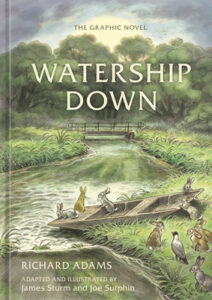Watership Down is a seminal book in the life of most young readers, and one I remember with great fondness from my own childhood. Re-reading it as an adult produced a slightly different, admittedly lesser experience, that I talked about briefly here. So how, I wondered, would experiencing it as a graphic novel change my perspective on the book again, if at all?
 Turns out that adapting the book to a graphic format is a shockingly good way of bringing me back to the magic of my initial childhood reading experience, untarnished by a more adult absorption in the text’s every word. I can’t be the only adult who goes back to read a favorite tome from their youth only to be confounded by how many more words there are in it than remembered? Or perhaps I am merely an impatient first-time reader, gobbling up words by the yard in pursuit of story instead of savoring each passage in its fulness, as I’m more likely to do on a re-read. It is also fairly rare for me to remember words on a page: instead, the books that linger in my memory remain there as vivid pictures and the feelings they evoke. Bigwig, for example, will always be a bad ass, both objectively and in my mind, tho darned if I can remember a single word he’s ever said.
Turns out that adapting the book to a graphic format is a shockingly good way of bringing me back to the magic of my initial childhood reading experience, untarnished by a more adult absorption in the text’s every word. I can’t be the only adult who goes back to read a favorite tome from their youth only to be confounded by how many more words there are in it than remembered? Or perhaps I am merely an impatient first-time reader, gobbling up words by the yard in pursuit of story instead of savoring each passage in its fulness, as I’m more likely to do on a re-read. It is also fairly rare for me to remember words on a page: instead, the books that linger in my memory remain there as vivid pictures and the feelings they evoke. Bigwig, for example, will always be a bad ass, both objectively and in my mind, tho darned if I can remember a single word he’s ever said.
So this reinterpretation, if you will, helped refocus my memories of the book and underscore things I probably hadn’t appreciated on my last re-read as an adult. A large part of this comes ofc from the creators’ decision to illustrate so much of the proceedings. That old saw of a picture being worth a thousand words helps in condensing Richard Adams’ initial prose to its most important parts, displaying the most impactful scenes in a way that suits (my perhaps idiosyncratic memory of) the material. I was definitely far more affected by sadness upon reading this than I had been my last go-round, tho less due to Bigwig this time than to the trials that befell Hazel.
Adaptor James Sturm freely admits that he actually cut out a lot of text, but not because the drawings sufficed to tell the whole story. Had he wanted to include as much as possible of the text, the graphic novel would have ballooned well past its nearly 400-page count, a hefty challenge for any reader and especially the reluctant ones targeted by this adaptation. Instead, his afterword points readers to the source material as an excellent way to explore more of the tales of El-ahrairah and other assorted lore, should they understandably get sucked in by the story.
And what is that story, for those of you who have yet to encounter its delights? Fiver is a small rabbit who has a premonition of death befalling his warren. With the help of his older, fitter brother Hazel, they gather a group of rabbits willing to listen and flee with them, despite the scoffing and outright physical attempts to stop them by the warren’s enforcers. Fiver’s prophecy comes to pass, but his group of rabbits must undergo great trials in finding and establishing a new home. Along the way, they learn so much about fairness, justice and compassion, along with courage and conviction.
As a very mid-to-late 20th century British tale, the book has its flaws, but there’s also so much to love. Yes, it’s annoying that female rabbits with distinct personalities only show up in the back third. This graphic novel adaptation also highlights the religiously allegorical underpinnings of the book, Mr Adams’ protests to the contrary (and in fairness, I’m inclined to agree that he did not mean for it to be about religion, despite the fact that it clearly turned out to be.) But Watership Down is also a brutally honest portrayal of nature’s conflict and violence, deftly examining government, politics and warfare in a way that kids can easily comprehend and digest. It isn’t perfect, but it’s a pretty darn good primer for resisting both fascism and the illusory comfort of deceit.
I really appreciated this adaptation of the classic novel, and am hoping it will help the book reach new generations of readers, as it certainly deserves. Joe Sutphin’s illustrations are both wonderfully kinetic and enchantingly pastoral, tho I admit that I did occasionally have trouble differentiating between individual rabbits who were not Bigwig. In the graphic novel’s defense, that’s a problem I also had with the source material: readers who take more time to savor the details likely won’t face that issue at all.
Watership Down: The Graphic Novel by Richard Adams, James Sturm & Joe Sutphin was published October 17 2023 by Ten Speed Graphic and is available from all good booksellers, including
